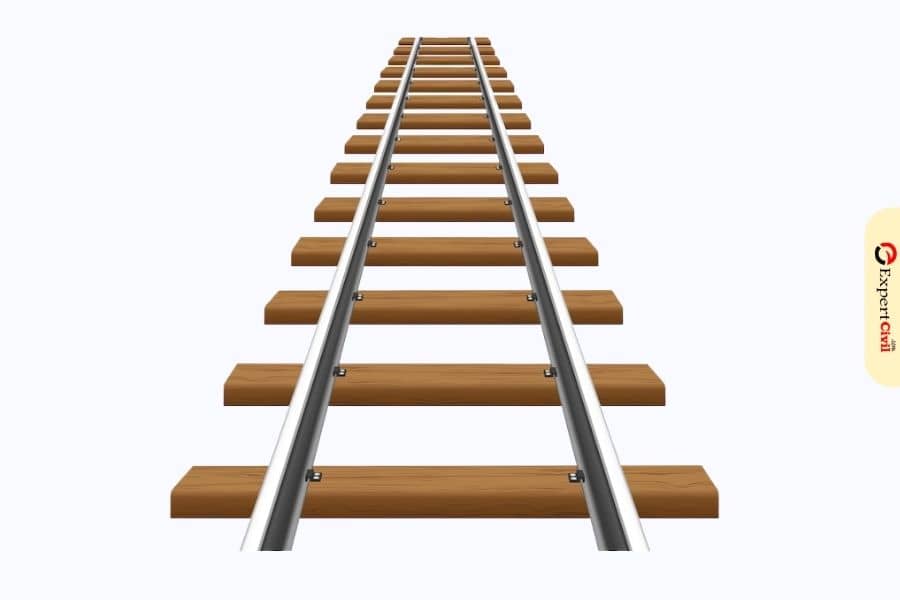What is Sleeper?
Sleeper: Railway sleepers are the members which are laid transverse to the rail. Sleepers are fixed in such a way that they transfer the load from the rails to the ballast and subgrade below. Railway sleepers are also known as “Railway ties “.

Functions of sleeper
The main functions of the sleepers are as follows;
- To hold the rails at a proper level
- To correct gauge
- To act as an elastic medium between the ballast and rails
- To adsorb the vibrations and blows of moving load on rails
- To distribute the load from the rails to the ballast
- To support the rails at a proper level on a straight track with proper superelevation
Properties of sleeper
- Sleepers should be inexpensive.
- Sleepers fittings should be such that they can be easily adjusted during maintenance operations
- The weight of the sleepers should not be too heavy or too light
- Sleepers should be capable of resisting shocks and vibrations.
Also read: Types of Road Margin in Highway
Types of sleepers
Railway sleepers can be classified into three types:
- Wooden Sleepers
- Metal Sleepers
- Concrete Sleepers
1. Wooden Sleeper
Wooden sleepers are also called as “Timber Sleepers”. Wooden Sleepers are considered as the best sleepers for railways. Life of these wooden Sleepers depends upon their ability to resist wear, attack by white ants, decay and their quality.

Advantages of Wooden sleepers
- These types of sleepers are easily available in all parts of India
- Fittings are few and simple in design
- Easy to lay, relay, lift
- Wooden sleepers are suitable for all types of ballast
- These types of sleepers are also very economical
Disadvantages of Wooden sleepers
- These sleepers have less service life i.e. 12 – 15 years.
- Its maintenance cost is high.
- These sleepers can be subjected to decay, attacked by white ants, spike killings, wrapping and cracking, etc.
2. Metal Sleepers
Metal sleepers should bear tensile and compressive stresses. They should be overall economical. They should provide sufficient area for rails.

Metal sleepers can be classified into two types:
#1 Cast Iron Sleepers
Cast Iron Sleepers are in greater use because it is less prone to corrosion.
Advantages of Cast Iron Sleepers
- These sleepers are uniform in strength and durability
- These are easy to manufacture and handling
- Maintenance is easier
- These sleepers have a good scrap value
- Gauge can be easily adjusted
- Frequent renewable is not required
Disadvantages of Cast Iron Sleepers
- These sleepers are not suitable for high-speed routes
- These sleepers required a large amount of ballast
- Fittings required are greater in number and difficult to maintain.
#2 Steel Sleepers
Steel sleepers have longer life i.e. 30 – 40 years.
Advantages of Steel sleepers
- Steel Sleepers have better stability.
- These sleepers are easy to maintain gauge
- These sleepers are not suitable for fire hazard
- It causes lesser damage during handling.
Disadvantages of Steel sleepers
- These sleepers can liable to corrosion.
- Overall cost is more than timber sleepers.
3. Concrete Sleepers
Concrete Sleepers are needed for better design and economy.

Advantages of Concrete Sleepers
- These sleepers have longer life i.e. 40 – 60 years
- These sleepers have better stability.
- These sleepers are not attacked by vermin and natural decay
Disadvantages of Concrete Sleepers
- Handling and laying these sleepers are difficult.
- These sleepers have no scrap value.
- These sleepers are so much heavy.
- These sleepers are not suitable for manual packing.
Also read: Coning of Wheels in railway


Leave a comment